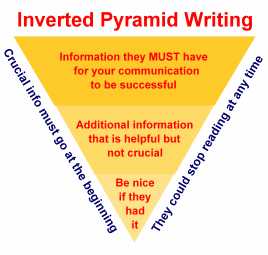The Inverted Pyramid: Journalism's Little Formula for Writing General News Stories
A Closer Look at the Inverted Pyramid
In news writing, the inverted pyramid style of writing ensures the most important information in a story reaches its audience first, with supporting details in subsequent paragraphs. With its stringent adherence to ordering information based on importance, the inverted pyramid is most often used by journalists writing hard news stories, as might appear on the front page or in section A of the paper.
In Detail: The Inverted Pyramid

Inverted Pyramid Origins
While there are many sources which allege when and how the inverted pyramid was created, most assessments find that the style was first introduced during the American Civil War, from 1861-1865.
Newspaper records of stories from the war, and prior to, reveal a dramatic shift in largely chronological reports, to stories written with the inverted pyramid style.
The reason for the shift to the inverted pyramid, some scholars speculate, was the frequency with which telegraph lines were cut, either by man or as an infrastructure casualty of war.
Newspaper editors including Horace Greeley of the New York Tribune, and Wilbur Storey of the Chicago Times, sought the freshest war news possible, a popular staple of the penny press during the war which exponentially increased profit and readership. Yet, with the threat of losing telegraph lines in battle, the editors began instructing war correspondents to organize their details in order of importance.
Thus, the inverted pyramid was born.
How to Write Using the Inverted Pyramid
After completing the news gathering process, journalists must organize their thoughts into three sections in the inverted pyramid:
- Information that must be conveyed
- Supporting information for the story's main point.
- Additional information which may be unnecessary, but relevant.
Take, for example, a school board meeting to discuss whether to reinstate a teacher accused of having an inappropriate relationship with a student. The police investigation last fall revealed the student lied about the incident.
You might find yourself with details about the alleged relationship, information about the police investigation, a general statement from the school's public information officer, and the identity of the teacher in question.
Since the allegations were made previously, and perhaps reported in your paper before, we an identify the school board meeting as the main topic, or angle, for your story.
Your lede, the first paragraph in news writing, should identify the who, what, when, where, why and how. A possible lede for this story may read:
The Springfield School District will consider reinstating a teacher falsely accused of an improper relationship with a student at the board of trustees meeting Tuesday.
The second paragraph should include information about the allegations, and the outcome of the police investigation.
Following the lede, writers should introduce supporting details in a logical manner.
Concluding paragraphs would likely include time, and location for the school board meeting.








